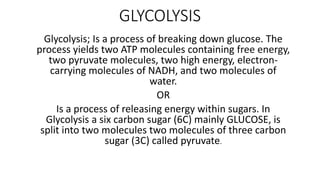
UNERSTANDING GLYCOLYSIS IN EASY 10 STEPS
- 1. GLYCOLYSIS Glycolysis; Is a process of breaking down glucose. The process yields two ATP molecules containing free energy, two pyruvate molecules, two high energy, electron- carrying molecules of NADH, and two molecules of water. OR Is a process of releasing energy within sugars. In Glycolysis a six carbon sugar (6C) mainly GLUCOSE, is split into two molecules two molecules of three carbon sugar (3C) called pyruvate.
- 2. The three (3) stages of Glycolysis. 1. Sugar phosphorylation. This is the first stage in glycolysis, in this stage the 6C sugar is activated and making it more reactive. ATP is used at this stage. Under this stage lie several steps that are;
- 3. STEP 1. Here, HEXOKINASE enzyme adds a phosphate group to the Glucose in the cells cytoplasm to form glucose-6-phosphate. One molecule of ATP is consumed giving ADP.
- 4. STEP 2. The ISOMARASE enzyme PHOSPHOGLUCOISOMERA SE isomerizes Glucose-6- phosphate (G6P) into it’s isomer Fructose-6- phosphate (F6P)
- 5. STEP 3. Then PHOSPHOFRUCTOKINASE uses another ATP molecule to transfer a Phosphate group to Fructose-6-phosphate in order to form Fructose- 1,6-bisphosphate. Two ATP molecules used so far.
- 6. STAGE TWO (2) 2. Lysis stage. This is the second stage, whereof the phosphorylated six carbon (6C) sugar is split into two molecules of three carbon (3C) sugar which are isomers of each other. This stage involves steps explained in next slides.
- 7. STEP 4. The enzyme aldolase splits fructose 1,6- bisphosphate into a ketone and an aldehyde molecule. These sugars, dihydroxyacetone phosphate (DHAP) and glyceraldehyde 3- phosphate (G3P), are isomers of each other.
- 8. STEP 5. • The enzyme triose-phosphate isomerase rapidly converts DHAP into G3P (these isomers can inter-convert). G3P is the substrate needed for the next step of glycolysis.
- 9. STEP 6. The enzyme glyceraldehyde 3- phosphate dehydrogenase (GAPDH) serves two functions in this reaction. First, it dehydrogenates G3P by transferring one of its hydrogen (H⁺) molecules to the oxidizing agent nicotinamide adenine dinucleotide (NAD⁺) to form NADH + H⁺.
- 10. Cont… •Next, GAPDH adds a phosphate from the cytosol to the oxidized G3P to form 1,3- bisphosphoglycerate (BPG). Both molecules of G3P produced in the previous step undergo this process of dehydrogenation and phosphorylation.
- 11. STEP 7. The enzyme phosphoglycero kinase transfers a phosphate from BPG to a molecule of ADP to form ATP. This happens to each molecule of BPG. This reaction yields two 3-phosphoglycerate (3 PGA) molecules and two ATP molecules.
- 12. STEP 8. The enzyme phosphoglycer omutase relocates the P of the two 3 PGA molecules from the third to the second carbon to form two 2- phosphoglycerate (2 PGA) molecules.
- 13. STEP 9. The enzyme enolase removes a molecule of water from 2-phosphoglycerate to form phosphoenolpyruvate (PEP). This happens for each molecule of 2 PGA from step eight.
- 14. STEP 10. The enzyme pyruvate kinase transfers a P from PEP to ADP to form pyruvate and ATP. This happens for each molecule of PEP. This reaction yields two molecules of pyruvate and two ATP molecules.
- 15. INPUT, OUTPUT AND NET GAIN. • Input in glycolysis are glucose molecules, 2NAD+ molecules and 2ATP molecules. • The output in the glycolysis are 4ATP molecules, 2pyruvate molecules and 2NADH+ • The net gain of ATP is 2 ATP
- 16. The fate of pyruvate is OXYGEN dependent aerobic or anaerobic, this depends on the presence or absence of oxygen. 1. In presence of OXYGEN (Aerobic), pyruvate is converted to acetyl by the enzymes pyruvate dehydrogenase, then enters the Krebs's cycle. 2. In absence of oxygen (anaerobic) conditions, pyruvate is converted to lactate by the enzyme lactate dehydrogenase. Pyruvate is also converted to acetaldehyde and furthermore to ethanol. FATE OF PYRUVATE